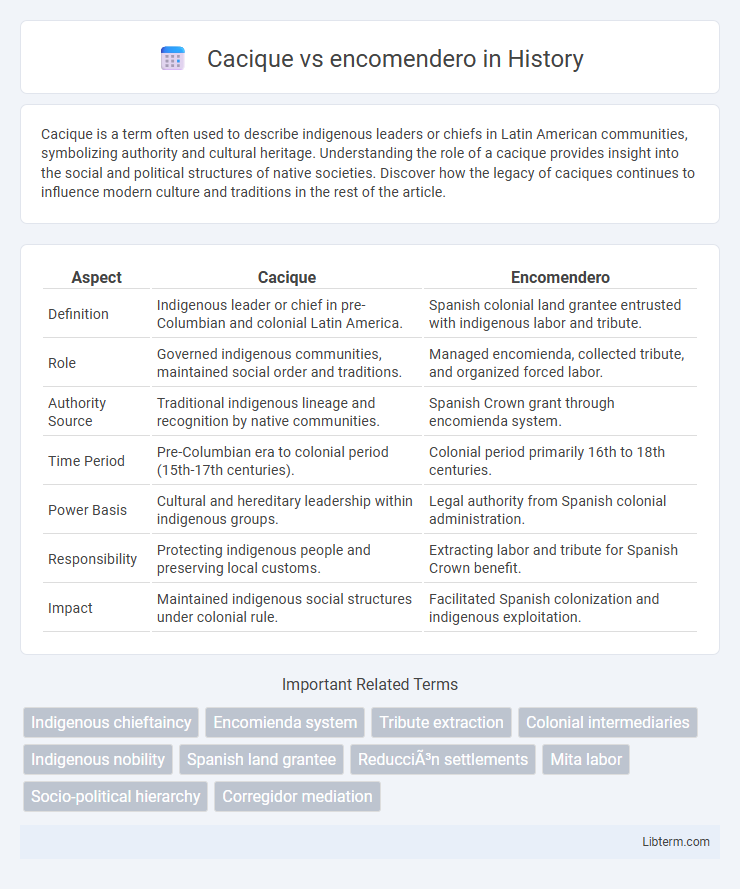Cacique is a term often used to describe indigenous leaders or chiefs in Latin American communities, symbolizing authority and cultural heritage. Understanding the role of a cacique provides insight into the social and political structures of native societies. Discover how the legacy of caciques continues to influence modern culture and traditions in the rest of the article.
Table of Comparison
| Aspect | Cacique | Encomendero |
|---|---|---|
| Definition | Indigenous leader or chief in pre-Columbian and colonial Latin America. | Spanish colonial land grantee entrusted with indigenous labor and tribute. |
| Role | Governed indigenous communities, maintained social order and traditions. | Managed encomienda, collected tribute, and organized forced labor. |
| Authority Source | Traditional indigenous lineage and recognition by native communities. | Spanish Crown grant through encomienda system. |
| Time Period | Pre-Columbian era to colonial period (15th-17th centuries). | Colonial period primarily 16th to 18th centuries. |
| Power Basis | Cultural and hereditary leadership within indigenous groups. | Legal authority from Spanish colonial administration. |
| Responsibility | Protecting indigenous people and preserving local customs. | Extracting labor and tribute for Spanish Crown benefit. |
| Impact | Maintained indigenous social structures under colonial rule. | Facilitated Spanish colonization and indigenous exploitation. |
Introduction to Caciques and Encomenderos
Caciques were Indigenous leaders or chiefs in pre-Columbian and colonial Latin America who held significant political and social authority within indigenous communities. Encomenderos were Spanish settlers granted rights by the Crown to extract labor and tribute from Indigenous populations through the encomienda system, often leading to exploitation. The dynamic between caciques and encomenderos shaped colonial governance, blending native authority with Spanish colonial control.
Historical Origins of Cacique and Encomendero Roles
The historical origins of the cacique role trace back to indigenous governance systems in pre-Columbian Latin America, where caciques functioned as tribal chiefs or local leaders responsible for social order and resource distribution within their communities. In contrast, the encomendero role emerged during the Spanish colonization in the 16th century, defined as a colonial settler granted authority by the Spanish Crown to extract labor and tribute from indigenous populations under the encomienda system. These distinct roles reflect the shift from indigenous political structures to Spanish colonial exploitation mechanisms, with caciques embodying native sovereignty and encomenderos representing imperial control.
Key Differences Between Caciques and Encomenderos
Caciques were indigenous leaders who held traditional authority within native communities in colonial Latin America, often maintaining social and political control over their people. Encomenderos were Spanish colonists granted rights by the Crown to extract labor and tribute from indigenous populations under the encomienda system, representing colonial authority and economic exploitation. The key difference lies in their roles: caciques symbolized native governance and cultural continuity, while encomenderos embodied colonial power and resource extraction.
Social Status and Influence in Indigenous Societies
Caciques held hereditary leadership roles within indigenous societies, commanding significant social status and influence over their communities through traditional authority and kinship ties. Encomenderos, European colonial settlers granted control over indigenous labor and lands by the Spanish Crown, wielded economic and political power but lacked intrinsic cultural legitimacy among native populations. The cacique's role centered on maintaining indigenous social structures, while encomenderos imposed external control, creating a complex dynamic of authority and social hierarchy during colonial rule.
Economic Power and Land Control
Caciques held significant economic power through hereditary control of land and tribute from indigenous communities, serving as intermediaries between colonial authorities and local populations. Encomenderos, granted land and labor rights by the Spanish Crown, amassed wealth by exploiting indigenous people and agricultural resources on encomiendas. While caciques maintained traditional authority and localized land control, encomenderos dominated broader economic systems, integrating native labor into colonial export economies.
Interactions with the Spanish Colonial Authorities
Caciques often acted as intermediaries between indigenous communities and Spanish colonial authorities, facilitating labor tributes and resource extraction under the encomienda system. Encomenderos held legal rights granted by the Crown to extract labor and tribute from indigenous populations, frequently leveraging their power over caciques to maintain control. These interactions created a complex dynamic where caciques navigated cooperation and resistance to protect their communities while encomenderos enforced colonial dominance.
Impacts on Indigenous Communities
Caciques served as indigenous leaders who maintained traditional social structures, often preserving cultural practices and local governance within their communities. Encomenderos, as Spanish colonial settlers granted control over indigenous labor and tribute, imposed forced labor and disrupted native social systems, leading to widespread exploitation and decline of indigenous populations. The encomienda system significantly altered indigenous livelihoods by undermining the authority of caciques and fostering economic dependency on colonial authorities.
Cacique and Encomendero Relationships and Conflicts
Caciques were indigenous leaders who maintained authority over their communities within the Spanish colonial framework, often serving as intermediaries between encomenderos and native populations. Encomenderos, granted control over land and labor by the Spanish Crown, relied on caciques to organize indigenous labor and tribute, leading to complex power dynamics marked by cooperation and tension. Conflicts arose as encomenderos imposed exploitative demands, undermining cacique authority and provoking resistance within indigenous societies.
Legacy in Modern Latin American Society
Caciques and encomenderos both left enduring legacies in modern Latin American society through land control and social hierarchy. Caciques represented indigenous leadership structures that adapted and persisted, influencing contemporary community governance and cultural identity. Encomenderos embodied colonial landholding elite power, shaping patterns of economic inequality and land distribution still evident today.
Conclusion: Enduring Significance of Caciques and Encomenderos
Caciques and encomenderos played pivotal roles in shaping the social and political landscapes of colonial Latin America, reflecting indigenous authority and Spanish colonial power, respectively. Their interactions influenced land management, labor systems, and cultural exchange, leaving a lasting impact on contemporary social hierarchies and governance structures. The enduring significance of caciques and encomenderos lies in their foundational contribution to the complexities of post-colonial identity and institutional evolution in the region.
Cacique Infographic

 libterm.com
libterm.com